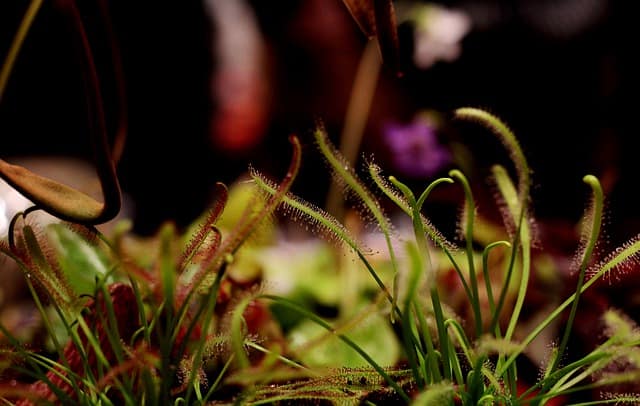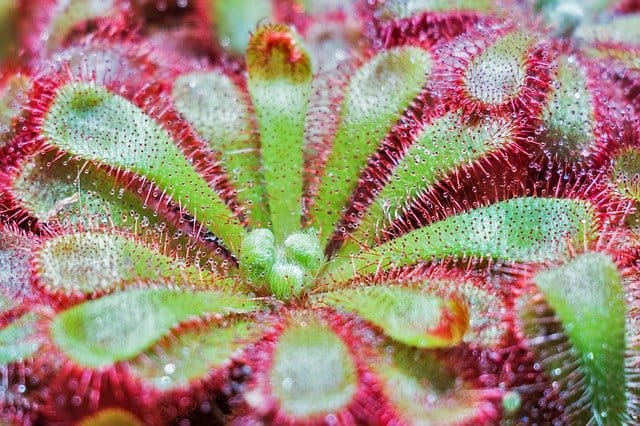Drosera plant dies when it doesn’t get adequate light. Browning of the foliage is seen when your Drosera is overfertilized. Sundew plants tend to die after flowering as the plant needs a lot of nutrients to blossom. Give your Drosera the needed nutrients immediately after flowering. Aphids, Spider mites, Mealybugs, and scale attack the Sundew plant.
Drosera plants look elegant indoors and they get rid of a good number of flies. What more could one ask for?
Drosera is also called the Sundew plant. They got the name coz of the dew on their trap leaves.
It’s not easy to maintain a Sundew plant indoors. You will be facing many challenges.
Many people report that their Drosera is dying. There can be many reasons.
Let’s talk about why your Drosera is dying and how to revive it.
Why are my Sundew leaves turning brown?
Sundew leaves turn brown when the plant gets more light than needed. Sundew leaves also turn brown when the plant gets more fertilizer than needed.
Light
You need to give these plants enough light be it artificial or natural. If the light is not enough the leaves may turn brown.
I put my grow lights on for 14 hours a day. My setup is two GE daylights that are 40W and 6500 lumens.
I put my lights 7 or 8 inches away from the plant.
Abundant light is essential to produce dew. Make sure your Sundew gets enough of it.
Too much fertilizer
Some people use Orchid fertilizers to feed their Sundews. This is not ideal in my opinion.
Just feed them some insects and they’ll thank you.
Many people seem to think that feeding a lot of fertilizer is good for plants. On the contrary, this can seriously harm your Drosera.
This may also lead to browning of the leaves.
Pests
Carnivorous plants can be infected by pests. Aphids, Scale, Spider mites, Mealybugs, and Powdery mildew can infect Sundew plants.
Look out for certain signs of infection and spray with Neem oil/pesticide if necessary.
Why are my sundew leaves turning black?
Sundew leaves turn black if they’ve been moved from one location to another. In this case, it’s a stress response. They need time to get used to the new location.
This also happens if they have been put in direct sunlight for too long. So make sure your plant doesn’t get stressed.
Acclimate your Sundew plant slowly to outside conditions before placing them for longer hours. This is also seen in plants where they’ve been transplanted recently.
Why are Sundew leaves curling?
Sundew leaves get curled due to light stress. Don’t put your Sundew for 8 hours directly out in the sun.
Let your Drosera adapt to the conditions before you expose them to the sun for long hours.
Aphid infection also causes Drosera leaves to curl up. Check for any signs of Aphid infection.
Why is my sundew not sticky?
Sundew plant fails to produce mucilage if the plant doesn’t get adequate sunlight. High humidity is necessary for dew drop production in Sundew plants.
Sundew plants are known and kept for their beautiful dew. But if it doesn’t produce the dew what’s the point of keeping it?
It’s not good for the plant too as it will not be able to catch prey.
There can be various reasons why your Sundew is not producing dew.
Mucilage production in Sundew plants is regulated to an extent by certain external factors. These include light, Temperature, Humidity, etc.
Light
Light is the most important factor affecting mucilage production.
Only water will be seen on the leaves if there isn’t enough light. This won’t be sticky and the plant won’t be able to catch prey.
If the plant gets too much light, the plant still won’t be able to produce dew. The plant will lose a lot of water thanks to transpiration.
So, try to give your Sundew enough light.
Temperature
Temperature is another external factor that can affect dew production.
High temperatures cause needless evaporation of water, thus lowering the production of dew.
Humidity
Humidity plays an important role in the production of larger dew drops by your Sundew plant.
High humidity is ideal for Sundews and you can achieve this by using a Humidifier.
Humidity in the range of 40%-50% is ideal.

Do Sundews die after flowering?
Yes, many species of Sundews may die after flowering if they are not fed well. Flowering demands a lot of energy and nutrients and if the plant runs out of them, it dies.
In most cases, the foliage dies but regrowth happens.
Should I let my Drosera flower?
No, I would not let my Drosera blossom. Flowering is a tedious process and the plant gets weak. The plant needs lots of nutrients to produce flowers.
Such plants die after flowering as they utilize most of the nutrients to produce blooms.
Do Sundews need dormancy?
Yes, Sundew plants need dormancy. Many Sundew plants undergo dormancy in winter. They save energy by doing so.
This phase is triggered by shorter photoperiods and lower temperatures from October to May.
During this period the leaves die back and the plant tries to remain idle.
The plant however recovers and grows vigorously in Springtime.
The above is true for temperate Sundew plants. There are some Sundew plants that need not go dormant.
Cape Sundews do not require and do not undergo dormancy. This is the primary reason why it’s the popular choice for beginners.
Do Sundews need humidity?
Yes, Sundew plants need humidity. It is very important for the normal production of dew. The ideal range of humidity is around 50%.
Set up a humidifier in the room if you want to increase the humidity around the Drosera.
How do you save a dying Sundew?
Is your Sundew plant really dying?
Many of our readers mistake dormancy for the death of the plant.
Remember! The plant becomes dormant in the winter.
If your plant shows dying signs, see what’s wrong.
It comes down to light, temperature, humidity, and water.
Light is the most common culprit here.
If all these are ideally provided, ask yourself the below question.
Is there any insect infestation?
If there is, spray the suitable insecticide.
Wrappin’ it up
Sundew plants are easy to take care of. If you are having a hard time, try Cape Sundews.
These plants are beginner-friendly.
Whichever Sundew you plan to keep, just provide ideal conditions and it will thrive!
If you like keeping carnivorous plants, you’ll love this article on pitcher plants.

